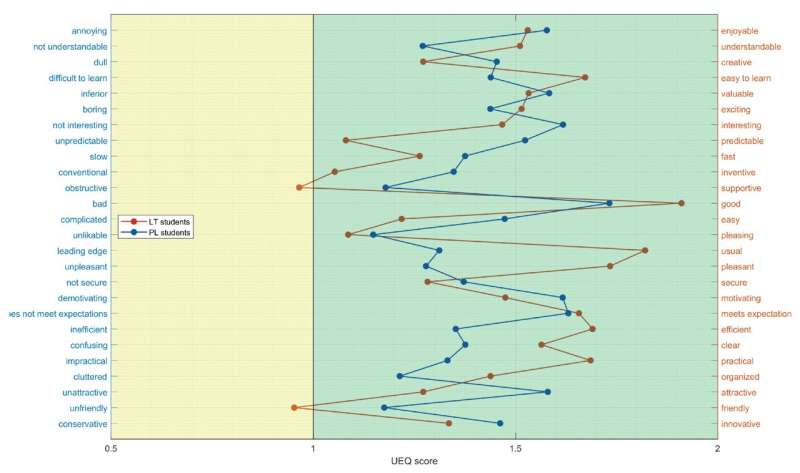This article has been reviewed according to Science X's editorial process and policies. Editors have highlighted the following attributes while ensuring the content's credibility:
fact-checked
trusted source
proofread
A new method will allow people to learn programming by playing

The changing information technology industry, latest artificial intelligence applications, high demand for IT professionals, and evolving need for learning are leading to the search for innovations in education that will allow current and future employees to acquire knowledge in a contemporary and accessible way.
This is particularly relevant in the field of programming, where the complexity of the process often creates learning difficulties. Researchers from Lithuania's Kaunas University of Technology (KTU) and universities in Poland, Portugal, and Italy are proposing to gamify this process.
Their paper is published in the journal Computers.
"Gamification is a learning method in which traditional game elements and principles such as levels, points or leader boards are used," explains KTU researcher Rytis Maskeliūnas.
According to him, the main goal of this approach is to make learning as enjoyable and challenging as a game. This dynamic method should encourage learners to become more involved in learning activities and help them retain information more easily.
A personalized learning process
The KTU professor highlights that the possibility to personally adapt the learning process based on each learner's specific needs, abilities, and level of progress is one of the main advantages of gamification.
Maskeliūnas says that such personal adaptation is a complex process, which starts with the identification of the student's initial knowledge, abilities, strengths, and weaknesses. Then, with the help of the AI or tutor, goals are selected and an individual learning plan is generated.
"The AI or teacher continuously monitors the learner's progress—if the students are learning quickly, they can move on, but if they are struggling, it is possible to stay at the same level or task as long as needed. It is clear that the personalization helps to maximize learning efficiency and allows the learner to improve to the best of his or her ability," comments Maskeliūnas, a co-author of the solution.
He adds that in today's world, gamified classroom experience is an especially important tool to improve the students' motivation.
According to the researcher, classical teaching methods are not adapting fast enough to provide up-to-date programming knowledge in a way that is acceptable to today's students, especially if there are gaps in the learning process. Such innovations in the IT sphere make it possible to partially address the identified problems.
Teachers are first to test the effectiveness of gamified learning
Although new, the gamification solution created by KTU and partners is already used in Lithuania. Under a special project of the Ministry of Education, Science and Sport, KTU is running a module on the subject of informatics, allowing teachers to retrain and acquire additional IT competencies. During this course, the learners have tried out the gamification.
KTU professor Tomas Blažauskas, who used the gamification solution with a group of teachers, says that he is satisfied with the successful application of the innovation and the positive feedback, remarking, "Indeed, the teachers had a positive reaction to the proposed solution, and there was a great deal of interest and support for the innovation."
The professor adds that the uniqueness of the approach has kept the learners interested and the aim of motivating them to study has also been achieved.
"The gamified tasks were optional, so it was good to see that most of the students were curious and willing to perform them. This, as the results showed, eventually led to better educational performance," mentions Blažauskas.
He says the teachers' willingness to use the tools in their schools was the greatest success in the trial.
"The fact that experts in the field of education understand the benefits of gamification and the potential of it makes the most sense," he shares, referring to the further integration of the method.
Further integration into educational setting faces challenges
The gamification solution was developed using progressive web applications (PWAs) widely used in e-commerce and media websites. According to Maskeliūnas, they allow content to be easily accessed from any device and adapted accordingly. Often, the applications work without internet access.
Unfortunately, although PWAs have great potential to facilitate the learning process, the integration of these web-based applications in an educational setting faces some challenges.
Firstly, there is a challenge of preparing the right digital content. Maskeliūnas argues that the process of converting content from a traditional format to a new one requires separate technical staff, and therefore, additional financial resources.
"The same applies to the incorporation of new technologies—expressing the need for it is not enough. Bureaucratic obstacles and resistance to change are likely to be encountered," says the professor.
However, the researcher immediately adds that the availability of electronic devices should not be the reason for the slow integration, as many learners have at least one smart device, and socially vulnerable groups can be provided with such devices in educational institutions.
Maskeliūnas also mentions the human factor in preparing for innovation, stating, "Apart from bureaucratic or infrastructural issues, the mindset of the learners, the lecturers or teachers needs to change—they need to understand these technologies, their meaning, and be able to use them."
More information: Rytis Maskeliūnas et al, FGPE+: The Mobile FGPE Environment and the Pareto-Optimized Gamified Programming Exercise Selection Model—An Empirical Evaluation, Computers (2023). DOI: 10.3390/computers12070144
Provided by Kaunas University of Technology





















